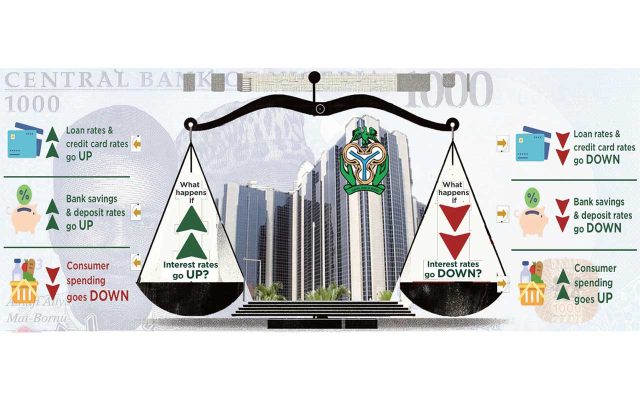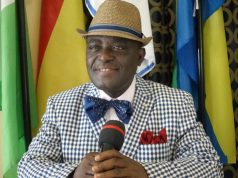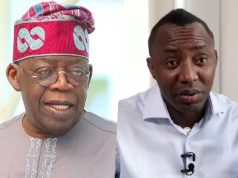• Calls for rate cut intensify
• Bank chiefs demand review of 50% cash reserves
• Interest rate cut may trigger fresh FX crisis
• Over 10% of current external reserves used to defend naira in H1, says report
The three-year monetary tightening run may be entering a new phase that could leave members of the Monetary Policy Committee (MPC) struggling to fend off external pressure to safeguard the integrity of its choices and keep the process strictly technical and professional.
This comes as calls for a rate cut intensify in the face of conflicting relevant data, including an uptick in the growth of money balances with a moderating inflation rate.
Whereas the international development partners have openly called on the Central Bank of Nigeria (CBN) to sustain the elevated interest rate, currently at 27.5 per cent (one of the highest globally), the pro-growth executive arm of government is said to be lobbying for a lower interest rate to complement its efforts to stimulate economic activities.
The ultra-high interest rate is worsened by restrictive prudential guidelines, including a 50 per cent cash reserve ratio (CRR) for deposit money banks (DMBs) that has made the cost of deposit liabilities extremely high for banks, thus feeding into the near-40 per cent commercial rates.
A few bank executives had openly questioned the rationale of sterilising 50 per cent of their deposits in an economy that is starved of funds. Whereas they cannot confront the regulators, the executives have been grumbling over the “unfair deal”, speaking through third parties occasionally, about the need to review the CRR.
The CRR is the proportion of deposits that banks are compelled to keep with the CBN as reserves and are not available for intermediation. Originally a prudential guideline, the CRR has grown into a liquidity (inflation)-managing tool.
The current CBN increased the ratio to serve as an additional liquidity control to avoid raising the interest rate far above its current level.
A top banker told The Guardian last week that the effective CRR exceeds 50 per cent as some banks are over-debited in many cases and are wondering why lenders should continue to pay interest on money it does not trade with.
Statutorily, banks pay 30 per cent of the subsisting MPR (8.25 per cent) on demand deposits, while time deposits are priced higher. The Guardian understands that bankers are entreating the apex banks to consider a downward review of the CRR, but could not confirm if the monetary authority has conceded to the request.
If the apex bank has yielded to the demand of operators, it could consider lowering the reserve ratio as an entry point to quantitative easing.
There seems to be consensus among economists that a 25 basis points (bps) interest rate cut is on the table at the 301st policy meeting, which takes off today in Abuja.
For Bismarck Rewane, a 25 bps rate cut is justified by declining domestic inflation and rising global inflation. By whatever methodology (old consumer price index (CPI) or the new one, Nigeria’s inflation is decelerating, which supports a rate cut.
Other economists share Rewane’s sentiment, which aligns with the desire of members of the executive arm of the government who are eager to score a political point with a faster growth rate. The current administration has its eye on a N1 trillion economy by 2030.
The Guardian’s independent data analysis, reported earlier, suggested that at the speed of last year’s 17 per cent nominal growth, Nigeria would need to tarry for over a decade to see a $1 trillion economy, supposing other things, including the naira exchange value, remain constant.
The government is counting on two possibilities to achieve the self-set goal – a recalibration of the gross domestic product (GDP) methodology and a change of the base year. The new methodology is expected to be used for the quarter one GDP data, which The Guardian learnt will be released by the first week of next month. It is yet unclear how much mark-up the rebasing will add to the current GDP size ($253 billion).
The government also expects the GDP growth rate to accelerate beyond its current 3.4 per cent, perhaps to align with President Bola Tinubu’s promised 12 per cent average growth rate in 2022 during his electioneering campaign.
High interest rate is a decreasing function of output growth. The President understands this; hence, during his inaugural speech, he promised to work with relevant agencies to achieve a single-digit interest rate, a far cry from the current 35 to 40 per cent commercial lending rates.
A single-interest interest rate stops at a dream in an economy where commercial banks shop for short-term liquidity from the apex bank, through the standard discount window, at 32.5 per cent.
The CBN, itself, on different occasions, rationalised the need for much lower interest rates. But in pushing for it, it may have been constrained by inflationary concerns. Now, it is under the pressure of both domestic analysts and the economic direction of the fiscal authority to start easing liquidity.
But that is just an aspect of the optics. The International Monetary Fund (IMF) and the World Bank are for a sustained tight monetary policy, arguing that inflation remains a major concern. This sits well with the Governor of the CBN, Yemi Cardoso, who repeated at the previous meeting that a single-digit inflation, which the country has not witnessed since 2016, remains the apex bank’s medium to long-term goal.
Apart from inflation concerns, the country may not have the firearm to defend the naira and keep it stable at its current level if it snaps. In the first half of the year, the bank spent $4.1 billion or about 12 per cent of its current gross reserves, to defend the naira, a report by CSL Stockbrokers noted. The amount was over three times what it spent in the same period of 2024, a year considered one of the toughest for the domestic currency.
An interest rate cut could reduce Nigeria’s competitiveness and trigger capital flight, which could reduce liquidity and expose the naira to short- to medium-term pressure, especially with the international crude market’s continual volatility.
Naira has had one of its longest stable runs in recent times, since last year. During the week, the currency closed at N1532.34/$ at the official market while the parallel market traded around N1535/$ at the weekend. The near-zero market arbitrage, besides the exchange value of the naira, experts have said, suggests the economic reforms are taking deeper root.
At the previous MPC meeting, a member, Murtala Sagagi, in his statement, said “the value of the naira has been relatively stable even though it is still considered undervalued and that it would appreciate to N1,450/$ by the end of the year.
Interestingly, the African Export-Import Bank (Afreximbank) is counting on a stable naira, rising purchasing power, moderating inflation and rising domestic oil refinery as support to push the economy to an average of four per cent real growth rate from 2025 to 2029.
At the meeting, the MPC members will be torn between retaining the current 27.5 per cent amid inflation easing and the business community’s expectation of a possible reduction of the rate.
But they will balance this with how to encourage capital inflow into the economy via portfolio investment to sustain the gains recorded in the FX market, observers have said.
A retired employee of the CBN, Dr Yunana Bature, noted: “I think that the monetary authorities have done very well so far in stabilising the naira. The differential between the official and unofficial rates has almost disappeared. That is magical considering where we are coming from.
“The next stage is to examine the rate to reduce it. Its reduction will allow the real sector to borrow to fund its operations. The gains made so far must be domesticated. That can only happen if facilities are made easy for the manufacturing sector. The real sector will continue to hobble until the rate of borrowing is brought down.”
Tolulope Alayande, another analyst, towed the same sentiment, saying: “The manufacturing sector must be encouraged to do its part by lowering the cost of borrowing. I hope inflation will continue to moderate to boost consumer spending. Once the manufacturing sector can function properly and is not encumbered, and the prices of food items are affordable, manufacturers will be encouraged to produce more, knowing their goods will be bought and the circle of production will move faster, benefiting the economy and the people.”







